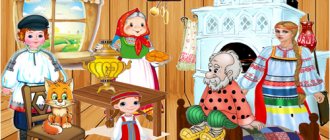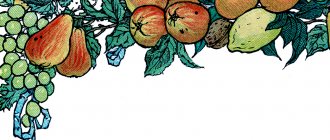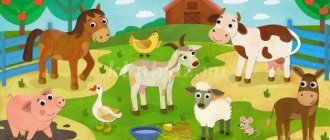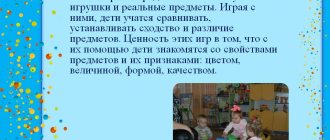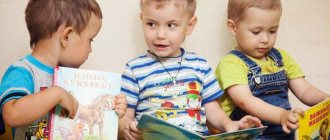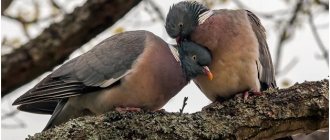Ecological game "GREEN CARDS"
Goal: to train children in matching the simplest food chains of animals in nature.
Material: a set of playing cards of 36 pieces, each painted green on the back, and illustrations of various plants and animals on the front, which are arranged in such a way that a total of 18 pairs are formed (the animal is food for it).
Progress of the game: from two to six children take part in the game. Each child is given 6 cards. It is checked in advance whether there are any among them that can be paired. If the child moves correctly, the cards are put aside. The number of cards is constantly replenished up to six until they run out. The winner is the one who leaves the game first or who has the fewest cards left.
Ecological game “Zoological Stadium”
Purpose of the game: to consolidate children's knowledge about various types of animals, their nutrition, and their habitats in nature.
Material: tablet on which two running tracks, start, finish and nine moves are depicted in a circle; in the center of the stadium there are six sectors with illustrations of animals: one - a squirrel, two - a bee, 3 - swallows, 4 - a bear, 5 - an ant, 6 - a starling.
Separate cards show illustrations of food for these animals and their shelters (hollow, beehive, den, anthill, birdhouse, etc.). The set also includes a die to determine the move.
Progress of the game: two children participate in the game. Using a die, they take turns identifying the sector with the task and make three moves: the first is to name the animal, the second is to determine the food for this animal, the third is to name its shelter in nature. The one who reaches the finish line first wins.
Ecological basket
Aibolit Pharmacy"
Purpose of the game: to continue to form children’s ideas about medicinal plants and their use by humans, to practice recognizing them in illustrations.
Material: flat basket with a red-green cross on one side, a set of illustrations of medicinal plants (St. John's wort, plantain, nettle, rose hips, chamomile, etc.).
Progress of the game: the teacher asks the children riddles about medicinal plants. The child finds an illustration in the basket, names the plant and explains why it is called the “Green Doctor.”
Similar games can be played on such topics as: “Mushrooms”, Edible and inedible mushrooms”, “Berries”, “Meadow flowers”, etc.
Ecological game "Forester"
Goal: to consolidate children’s knowledge about the rules of human behavior in the forest; practice recognizing environmental warning signs.
Material: a set of triangular-shaped warning environmental signs depicting forest objects (anthill, berries, lily of the valley, edible and inedible mushrooms, cobwebs, butterflies, birdhouses, bird's nests, fires, hedgehogs, etc.).
Progress of the game: children take turns playing the role of a forester who selects one of the environmental signs lying upside down on the table and introduces the game participants to the forest objects that this sign represents; tells how to behave in the forest when near these objects.
Ecological game “WALK IN THE FOREST”
Goal: to form the right attitude towards forest inhabitants, expand children’s knowledge about the rules of behavior in the forest, and practice recognizing warning and prohibiting environmental signs.
Material: tablet with a picture of a forest clearing with several paths on which warning signs are placed; a set of prohibitory environmental signs in an envelope (for example, do not pick lilies of the valley; do not trample mushrooms, berries; do not break tree branches; do not destroy anthills; do not make fires; do not catch butterflies; do not shout; do not play loud music; do not destroy bird nests, etc. .; silhouettes of children that can be moved along the paths).
Progress of the game: The game can involve a group of children who go for a walk in the forest. At the first stage, you should lead the children along the path, tell them what is on it, and put up the appropriate environmental signs to help them follow the rules of behavior in the forest.
At the second stage, children independently travel along forest paths where various environmental signs are placed. Players must use them to explain the rules of conduct in the forest. For the correct answer - a chip. The one who collects the maximum number of chips wins.
Ecological game “BIRDS PYRAMID”
Goal: to continue to develop in children knowledge about the simplest food chains of birds in nature, to consolidate knowledge about the conditions necessary for the growth of plants and the life of animals.
Material:
The first option is planar: a set of cards of different colors (blue, yellow, black, red), simulating the conditions necessary for the growth of plants and the life of animals; sets of three cards with different illustrations of plants and birds (for example, pine - pine cone - woodpecker).
The second option is three-dimensional: a set of seven cubes, where the first to fourth cubes are of different colors, indicating the conditions necessary for the life of plants and animals; fifth - plants; sixth - bird food; seventh - birds (for example: spruce - fir cone - crossbill; rowan - rowan berries - bullfinch; algae - snail - duck; oak - acorns - jay; grass - grasshopper - stork).
Progress of the game: by analogy with the “Ecological Tower “Forest”. However, when making a pyramid, you need to pay attention to the following rules: multi-colored cubes are placed horizontally, and three cubes with illustrations of plants and animals are placed vertically on this horizontal line, one on one, in order to show food chains in nature.
"ECOLOGICAL TOWER "FOREST"
Goal: to introduce children to the concept of “food chain” and give an idea of food chains in the forest.
The first option is planar: a set of cards with illustrations of four each (for example, forest - plant - herbivore - predator);
The second option is three-dimensional: four cubes of different sizes, on each side of which there are illustrations of a forest (forest - mushroom - squirrel - marten; forest - berries - hedgehog - fox; forest - flower - bee - bear; forest - acorns - wild boar - wolf; forest - birch - chafer - hedgehog; forest - pine cone - woodpecker - eagle owl, etc.)
Progress of the game: at the first stage, children play together with the teacher, starting the game with any cube.
Educator: “This is a mushroom, where does it grow?” (In the forest.) “Which animal eats mushrooms in the forest?” (Squirrel.) “Does she have enemies?” (Marten.) Next, the child is asked to create a food chain from the named objects and explain his choice. Show that if you remove one of the components of the food chain (for example, a mushroom), then the entire chain falls apart.
At the second stage, children play independently. They are invited to create their own ecological tower.
At the third stage, competition games are organized: who can quickly build a tower containing, for example, a hedgehog or a wolf.
Game "Sun"
Goal: to continue to consolidate children's knowledge about animals and their habitats.
Material: a set of task cards and wooden clothespins of different colors.
The task card is a circle divided into 6–8 sectors. Each sector contains a picture (for example: mole, octopus, fish, whale, cow, dog). In the center of the circle is the main symbol that defines the theme of the game (for example: a drop symbolizing water). The symbol helps children understand the task without the help of an adult.
Progress of the game. A drop is depicted in the center of the circle; the child must find animals for which water is a “home”, a habitat (lesson block “Water Sorceress”).
The content of several pictures in the sectors is related to the theme of the game, the rest of the pictures have nothing to do with it. When completing tasks, the child marks the necessary (that is, related to a given topic) sectors, for example, with blue clothespins, and those not related to it with red ones. Thanks to clothespins, the card with the completed task becomes like a sun.
Didactic game “Find what I’ll show you”
Topic: Fruits.
Equipment: Place identical sets of vegetables and fruits on two trays. Cover one (for the teacher) with a napkin.
Progress of the game: The teacher briefly shows one of the objects hidden under the napkin and removes it again, then asks the children: “Find the same one on another tray and remember what it’s called.” Children take turns completing the task until all the fruits and vegetables hidden under the napkin are named.
Note. In the future, the game can be complicated by adding vegetables and fruits that are similar in shape but different in color. For example: beets, turnips; lemon, potatoes; tomato, apple, etc.
Didactic game “Find what I will name”
Topic: Fruits.
First option.
Equipment: Place vegetables and fruits on the table so that their size and shape are clearly visible. For the game, it is better to take fruits and vegetables of the same size, but of different colors (several apples), of different sizes with a constant color.
Progress of the game. The teacher asks one of the children: “Find a little carrot and show it to everyone.” Or: “Find a yellow apple, show it to the children”; “Roll the apple and tell me what shape it is.” The child finds an object, shows it to the other children, and tries to determine the shape. If the child finds it difficult, the teacher can name a bright distinctive feature of this fruit or vegetable. For example: “Show me the yellow turnip.
Second option. Vegetables and fruits are placed in vases of various shapes: spherical, oval, elongated. In this case, the shape of the vase must correspond to the shape of the object hidden in it. Children are looking for the named object. You cannot look into all the vases.
Third option. The game is equipped and played in the same way as in the first two versions. Here the problem is solved - to fix the coloring of objects in the memory of preschoolers. Fruits and vegetables are laid out (hidden) in vases of different colors in accordance with the color of the item.
Didactic game “Guess what you ate”
Topic: Fruits.
Didactic task. Find out the object using one of the analyzers.
Equipment. Choose fruits and vegetables of different tastes. Wash them, peel them, then cut them into small pieces. The same objects are laid out on the table in the room where the children are sitting for comparison and control.
Rules of the game. You can't look at what you put in your mouth. You have to chew with your eyes closed, and then say what it is.
Progress of the game. Having prepared vegetables and fruits (cut into pieces), the teacher brings them into the group room and treats one of the children, after asking him to close his eyes. Then he says: “Chew well, now tell me you ate it.” Find the same one on the table.”
After all the children have completed the task, the teacher treats all children to fruits and vegetables.
Note. In the future, you can ask children to name taste sensations. The question should be asked in such a way that, in cases of difficulty, children can choose the appropriate name to determine the taste: “How did it feel in your mouth?” (Sweet, sour, bitter).
Didactic game “What has changed?”
Topic: Houseplants
Didactic task. Find objects by similarity.
Equipment. Identical plants (3 - 4 each) are placed on two tables.
Rules of the game. You can show a recognized plant only upon a signal from the teacher, after listening to its description.
Progress of the game. The teacher shows a plant on one of the tables, describes its characteristic features, and then invites the child to find the same one on another table. (You can ask the children to find similar plants in the group room.)
The game is repeated with each of the plants on the tables.
Didactic game “Find a plant by name”
Topic: Houseplants.
First option.
Didactic task. Find a plant by name word.
Rule. You cannot look where the plant is hidden.
Progress of the game. The teacher names a houseplant in the group room, and the children must find it. First, the teacher gives a task to all the children: “Who can quickly find the plant in our group room that I name?” Then asks some children to complete the task. If it is difficult for children to find the named plant in a large area of the room among many others, the game can be played by analogy with the previous ones, that is, the selected plants can be placed on the table. Then finding a plant in the room will become a more complicated version of the game.
Second option. You can play a game using a toy that the teacher or one of the children will hide (see the game “Where is the nesting doll hidden?”), but instead of describing the houseplant near which the toy is hidden, you can only give its name.
Didactic game “Find the same one”
Topic: Houseplants.
Didactic task. Find objects by similarity.
Rule. It is impossible to watch how the teacher changes places of plants.
Equipment. 3-4 identical plants are placed on two tables in a certain sequence, for example, flowering geranium, ficus, fragrant geranium, asparagus.
Progress of the game. The teacher asks the children to take a good look at how the plants stand and close their eyes. At this time, he swaps the plants on one table. And then he asks the children to rearrange the pots as they stood before, comparing their arrangement with the order of the plants on another table.
After some repetitions, you can play the game with one set of plants (without visual control).
Didactic game “Find the piece of paper that I’ll show you”
Topic: Trees.
Didactic task. Find objects by similarity.
Rule. Only those who have in their hands the same stock as the one shown by the teacher can run (“fly”) on command.
Progress of the game. During the walk, the teacher shows the children a sheet and asks them to find the same one. The selected leaves are compared by shape, and how they are similar and how they differ is noted. The teacher leaves each person a leaf from different trees (maple, oak, ash, etc.). Then the teacher picks up, for example, a maple leaf and says: “The wind blew. These leaves flew off. Show me how they flew." The children, holding maple leaves in their hands, spin around and stop at the teacher’s command.
The game is repeated with different leaves.
Didactic game “Find the same leaf in the bouquet”
Topic: Trees.
Didactic task. Find an item by similarity.
Rule. Raise the sheet after the teacher names and shows it.
Equipment. Select identical bouquets of 3 - 4 different leaves. The game is played while walking.
Progress of the game. The teacher distributes bouquets to the children and keeps the same for himself. Then he shows them some leaf, for example a maple one, and suggests: “One, two, three - show me this leaf!” Children raise their hand with a glue sheet.
The game is repeated several times with the remaining leaves of the bouquet.
Didactic game “Such a leaf, fly to me”
Topic: Trees.
Didactic task. Find objects by similarity.
Rule. You can run to the teacher only at a signal and only with the same piece of paper as the teacher’s in your hand.
Equipment. Select leaves of oak, maple, rowan (or other trees common in the area) that differ sharply in shape.
Progress of the game. The teacher picks up, for example, a maple leaf and says: “Whoever has the same leaf - come to me!” Children look at the leaves received from the teacher; those who have the same ones in their hands run to the teacher. If the child makes a mistake, the teacher gives him his sheet for comparison.
Didactic game “Find the leaf”
Topic: Trees.
Didactic task. Find a part from the whole.
Rule. You can look for a leaf on the ground after the teacher’s words.
Progress of the game. The teacher asks the children to carefully examine the leaves on a low tree. “Now try to find the same ones on earth,” says the teacher. -One, two, three - look! Whoever found it, come to me quickly.” Children with leaves run to the teacher.
Didactic game “Who can find birch, spruce, oak faster”
Topic: Trees.
Didactic task. Find a tree by name.
Rule. You can run to the named tree only with the command “Run!”
Progress of the game. The teacher names a tree that is well known to the children and has bright distinctive features and asks them to find it, for example: “Who can find the birch faster? One, two, three - run to the birch!” Children must find a tree and run up to any birch tree growing in the area where the game is being played.
Didactic game “Find a leaf like on a tree”
Topic: Trees.
Didactic task. Find a part from the whole.
Rule. You only need to look on the ground for the same leaves as on the tree indicated by the teacher.
Progress of the game. The game is played in the fall on the site. The teacher divides the group of children into several subgroups. Everyone is invited to take a good look at the leaves on one of the trees, and then find the same ones on the ground.
The teacher says: “Let's see which team finds the right leaves faster.” The children begin their search. Then the members of each team, having completed the task, gather near the tree whose leaves they were looking for. The team that gathers near the tree first wins.
Didactic game “Everyone go home!”
Topic: Trees.
Didactic game. Find the whole from its part.
Rule. You can run to your “house” only upon a signal from the teacher.
Equipment. Leaves of 3 - 5 trees (according to the number of children).
Progress of the game. The teacher hands out leaves to the children and says: “Let’s imagine that we went on a hike. Each squad pitched a tent under a tree. You are holding leaves from the tree under which your tents are located. We are walking. But suddenly it started to rain. “Everyone go home!” At this signal, the children run to their tents and stand next to the tree from which the leaf comes.
To check whether the task was completed correctly, the child is asked to compare his leaf with the leaves on the tree to which he ran up.
Note. The game can be played with leaves, fruits and seeds or only with seeds and fruits.
Didactic game “Find the tree by description”
Topic: Trees.
Didactic task. Find an item by description.
Rule. You can look for a tree only after the teacher tells you.
Progress of the game. The teacher describes trees familiar to the children, choosing from them those that have subtle distinctive features (for example, spruce and pine, rowan and acacia). Children must find what the teacher is talking about.
To make it interesting for the children to search by description, you can hide something near the tree (or on the tree) they are talking about.
Didactic game “Run to the house I’ll name”
Topic: Trees.
Didactic task. Find an item by name.
Rule. You cannot stand near the same tree for a long time.
Progress of the game. The game is played according to the “Trap” type. One of the children is appointed as a trap, all the rest run away from him and save themselves near a tree named by the teacher, for example, near a birch tree. Children can run from one birch tree to another. The one who is caught by the trap becomes the driver.
When the game is repeated, the name of the tree (“house”) is changed each time.
Didactic game “Who lives where?”
Topic: Dwellings
Goal: to consolidate children’s knowledge about the habitats in nature of various animal species (insects, amphibians, birds, animals).
Material: a tablet on which, on one side, various animals are depicted, and on the other, their homes, for example: a den, a hole, a beehive, a birdhouse, a nest. In the envelope on the back of the tablet there are arrows indicating the number of animals. Instead of arrows, you can draw labyrinths of multi-colored lines.
How to play: Two or more children take part in the game. They take turns finding the animal on offer and using an arrow or using a labyrinth to determine its home. If the game actions are performed correctly, the child receives a chip. If the answer is incorrect, the turn goes to the next player. The one who has the most chips at the end of the game wins.
Didactic game “Who eats what?”
Topic: Nutrition.
Goal: to consolidate children’s knowledge about different types of animal nutrition (insects, amphibians, birds, animals) in nature.
Material: a tablet on which different types of food for different animals are placed in a circle. A moving arrow is fixed in its center, and cards with illustrations of the necessary animals are placed in the envelope on the reverse side.
How to play: Two or more children participate in the game. One by one, according to the teacher’s riddle, the children find the corresponding picture of the animal and use the arrow to indicate the type of food it eats. For the correct answer - a chip. The one who has the most chips at the end of the game wins.
Didactic game “Find your house”
Topic: Nutrition.
Goal: to train children in grouping animals according to their feeding methods (herbivores, carnivores, omnivores, parasites).
Material: a set of cards with illustrations of different types of animals; four multi-colored fields for placing cards (green for herbivores, red for predators, green-red for omnivores and black for parasitic animals).
Progress of the game:
Option 1. Children play alone. The child groups cards with animals into colored fields depending on what they eat. After completing the task, the teacher checks the correctness of the solution and gives the player a penalty chip for each mistake. The one who collects them least wins.
Option 2. Children take turns taking one card with a picture of an animal and find a house for it, relying on their own knowledge about the feeding habits of different types of animals. The one who collects the most chips for completing the task correctly wins.
Didactic game “What first, what then?”
Topic: Growth.
Goal: to consolidate children’s knowledge about the main stages of growth and development of living organisms (plants, animals, humans).
Material: a set of cards that record the stages of growth and development of plants or animals (peas, dandelions, strawberries, frogs, butterflies, etc.), as well as humans (infancy, childhood, adolescence, adolescence, maturity, old age).
Progress of the game:
Option 1. The child is asked to arrange the cards in order of growth and development of a living creature (for example, cabbage butterfly: egg - caterpillar - pupa - butterfly) and tell what happened first and what came next.
Option 2. The teacher lays out the cards, deliberately making a mistake in their order. Children must correct her and explain the correctness of their decision.
Didactic game “Let’s help the plant”
Topic: Growth.
Goal: to consolidate children’s knowledge about the conditions necessary for plant growth (water, light, heat, nutritious soil); exercise in determining the deficiency of certain conditions by the appearance of the plant.
Material: a set of cards depicting one of the indoor plants (for example, balsam) in good and bad condition (withered, yellowed leaves, light soil in a flowerpot, frozen plant, etc.); four color model cards depicting the conditions necessary for plants (yellow—light, red—warmth, blue—water, black—nutrient soil); four cards depicting a healthy plant and modeling the four conditions it needs.
Progress of the game:
Option 1. At the beginning of the game, children are introduced to model cards of the conditions necessary for the growth and development of a plant. Then four cards are examined showing the same plant in good condition, indicating the same models. Children need to explain the reason for the normal state of the plant.
Option 2. Model cards are laid out on the table in front of the child, and on the typesetting canvas the teacher writes a story about the plant, for example: “I grew balsam in a pot on the window and rejoiced at the first spring sun. The sun's rays were heating up more and more, and the water reserves in the soil were becoming less and less. On Monday morning, the children noticed that the balsam leaves had turned yellow and drooped. What to do?" Invite the children to help the plant: select model cards depicting the conditions necessary for the plant. For the correct answer - a chip. The one who collects the most of them wins.
Didactic game “The forest is a home for animals”
Topic: Natural community.
Goal: to consolidate children's knowledge about the forest as a natural community; to form ideas about the ecological tiers (floors) of a mixed forest and the place of animals in them.
Material: planar model depicting four tiers of mixed forest: 1 - herbaceous cover, 2 - shrubs, 3 - deciduous trees, 4 - coniferous trees. On each of the tiers there are special slots for attaching animal figures. The envelope on the back of the tablet contains silhouette figures of various animals: insects, amphibians, reptiles, birds, mammals.
Progress of the game:
Option 1. Children play one at a time, and the rest check the correctness of the task - to place all the animals on “floors” depending on their habitat. The one who makes the fewest mistakes wins.
Option 2. Silhouettes of animals are laid out on the table with the reverse side up. Children take one silhouette at a time, name the animal and determine its place in the forest. In this case, the child must explain the correctness of his own choice. For the correct answer - a chip. If the task is completed incorrectly, then the animal silhouette figurine is placed on the table and the action is repeated by another child.
Didactic game “Ecological pyramid “Birds”
Topic: Birds.
Goal: to develop knowledge about the simplest food chains of birds in nature; consolidate knowledge about the conditions necessary for plant growth and animal life.
Material:
Option 1, planar: a set of cards of different colors (yellow, blue, red, black), displaying the conditions necessary for plant growth and animal life; sets of three cards with different illustrations of plants and birds, for example: pine - pine cone - woodpecker.
Option 2, volumetric: sets of seven cubes, where four cubes are of different colors, based on the conditions necessary for the life of plants and animals; the fifth shows plants; on the sixth - bird food; seventh - birds. For example: rowan - rowan berries - bullfinch; spruce - fir cone - crossbill; oak - acorns - jay; algae - snail - duck; grass - grasshopper - stork.
Game flow: Similar to previous games. However, when making a pyramid, you need to pay attention to the following rules: multi-colored cubes are placed horizontally, and three cubes with illustrations of plants and animals are placed vertically on this horizontal line, one on one, to show food chains in nature.
Didactic game “Walk in the forest”
Topic: Behavior in the forest.
Goal: to form the right attitude towards forest inhabitants; expand children's knowledge about the rules of behavior in the forest; practice recognizing warning and prohibiting environmental signs.
Material: tablet with a picture of a forest clearing with several paths on which warning signs are placed; silhouettes of children that can be moved along paths; a set of prohibitory environmental signs in an envelope (“Do not pick lilies of the valley”; “Do not trample mushrooms and berries”; “Do not break tree branches”; “Do not destroy anthills”; “Do not make fires”; “Do not catch butterflies”; “Do not shout” ; “Don’t play loud music”; “Don’t destroy birds’ nests”, etc.).
Progress of the game:
The game can involve a group of children who go into the “forest” for a walk. At the first stage, you should lead the children along the “path”, tell them what is on it, and put up the appropriate environmental signs to help them follow the rules of behavior in the forest.
At the second stage, children independently travel along “forest paths” where various environmental signs are placed. The guys must use them to explain the rules of conduct in the forest. For the correct answer - a chip. The one who collects the maximum number of chips wins.
Didactic game “Food chains in nature”
Goal: to form children’s ideas about food chains and the place of different animal species in them.
Material:
Option 1: pictures cut into two parts, when compiled, a food chain is formed: the animal and the food it eats, both plant and animal.
Option 2: pictures cut into three parts, the food chain includes a plant, a herbivore or omnivore, a predator.
Progress of the game:
At the first stage
The cut pictures are presented in such a way that each has its own specific cut, different from the others. Using it, children find parts of the corresponding picture, put them together correctly, become familiar with the food chain, and determine the place of the animal in it, for example: mushroom - squirrel - marten.
At the second stage
cut pictures can have the same cuts. When drawing up such pictures, children show greater independence in determining the place of the animal in the food chain.
Didactic game "Seasons"
Topic: Natural community.
Goal: to form ideas about the patterns of the seasons in accordance with the length of daylight hours; show the relationship between daylight hours and phenomena occurring in nature in different seasons.
Material: four tablets of different colors corresponding to the seasons (white, red, green, yellow), which show models of daylight hours for each season; pockets for illustrations of natural phenomena characteristic of a given season.
Progress of the game:
Children look at the tablets, determine each season in accordance with the color and trajectory of the sun in the sky: in summer - the largest trajectory, in winter - small; autumn and spring - equinox. Having determined the time of year, children should put illustrations of natural phenomena of this season in pockets and talk about them.
Didactic game “Ecological chamomile”
Topic: Natural community.
Goal: to consolidate children’s ideas about characteristic phenomena in living and inanimate nature in different seasons, their relationships and interdependence.
Material: four circles (centers of a daisy) of different colors (white, green, yellow, red) in accordance with the patterns of the seasons and a set of petals depicting various phenomena in living and inanimate nature at each time of the year, for example: in the spring, boats float in a stream, the lily of the valley has blossomed, birds are making nests, etc.
Progress of the game:
Four children play, each needs to collect chamomile petals of the corresponding season and talk about characteristic phenomena in both inanimate and living nature.
Didactic game “Enchanted Letter”
Topic: Fruits and vegetables.
Goal: to consolidate children’s ideas about the characteristic features of vegetables and fruits, their role in maintaining human health; introduce modeling as a way to form a generalized idea of vegetables and fruits.
Material: five tablets with models of characteristic features of vegetables and fruits (color, shape, size, method of eating, place of growth); a set of subject-schematic drawings for nasty vegetables and fruits.
Progress of the game:
Children examine subject-schematic models that reveal the characteristic features of vegetables and fruits.
Option 1. Using sample models of characteristic features of vegetables and fruits, children solve riddles and drawings by Dr. Aibolit to help him determine which vegetables and fruits are good for human health.
Option 2. Based on the model samples, one child makes up a riddle describing a particular vegetable or fruit, the rest of the children guess and tell what role they play in maintaining human health.
Didactic game "FLOWER-SEMIFLOWER"
Topic: Natural community
Goal: develop thinking; cultivate positive moral qualities of the individual; develop communication skills between children and their relatives; update joint needs; develop a sense of mutual empathy.
Progress of the game:
Each family team receives a seven-flowered flower. The participants in the game come up with seven wishes (parents help write down the wishes of preschoolers): three wishes are made by the child for the parents, three by the adult for the child, one wish will be shared.
Parents and children exchange petals and select wish petals that are truly pleasant to them. The team that has the most desired petals, where the expected desires coincide with the real ones, wins.
Didactic game “CONVERSATION WITH THE FOREST”
Goal: to develop children’s creative imagination, enrich speech with definitions; learn to relax.
Progress of the game:
An unusual journey awaits you. We will be transported mentally to the forest. (Children close their eyes, leaning on the backs of chairs, relaxed hands resting on their knees.) Around you in the forest are a variety of flowers, shrubs, trees, and herbs.
Stretch your right hand forward and “touch” the tree trunk: what is it like? Now raise your hand and touch the foliage: what is it like? Put your hands down and run along the blades of grass: what are they? Smell the flowers, take a deep breath and hold this freshness within yourself!
Submit your face to the fresh breeze. Listen to the sounds of the forest - what did you hear?
The children listen silently. Each child tells the teacher in his ear the sound or rustle he presents.

